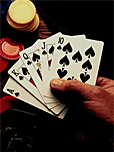Baccarat Card Game: Look for Origins in China
Though baccarat is believed to be originated from European countries, such as Italy and France, this statement can be easily appealed because of Pai Gow's existence. This tile game, which is extremely popular in China, is sometimes considered to be the forefather of modern baccarat.

The name of the game Pai Gow is translated as "Make a Nine" from Chinese (as far as we know, this is actually the object of modern baccarat: 9 is the maximum number of points a player may get during the game). The theory is that Pai Gow migrated from China to Italy in the 14th century together with Chinese immigrants, and it was played with Tarot cards there first.
What is Pai Gow, and how it was played that the theory of its connection with baccarat appeared?
Pai Gow
The game of Pay Gow is played not with cards but dominoes which is played even now in big Chinese casinos; it is also popular in Canada, Australia, New Zealand and, certainly, the USA. The rules of Pai Gow is quite interesting though they do not remind baccarat's ones at all (except the prohibition to exceed 9 points).
First of all, all tiles are shuffled on the table and bets are made afterwards; then both a player and a dealer are given four tiles which are then divided into 2 hands (2 hands of 2 tiles each). Two types of such hands exist:
- Frond hand - the hand of a lower value
- Rear hand - the hand of a higher value
The player wins the game if both his/her hands exceed both dealer's ones; if both player's hands lose a dealer's ones, then a dealer wins the game. If the only one player's hand exceeds a dealer's hand but the second one loses, it means PUSH and a player gets his/her bet back but wins nothing.
Seven players maximum take part in a game at the table; each of them receives his/her 2 hands of tiles but they are counted only against of a dealer's hand.
All scores are counted as well as baccarat:
- points are maximum.
- All points which exceed 9 are counted in a way to make 9: 6 + 5 = 11 = 1 + 1 = 2 for example.
- There are some special moments in Pai Gow when a player may exceed 9 and get 10 or eleven points (they are called to be Gongs and Wongs).





